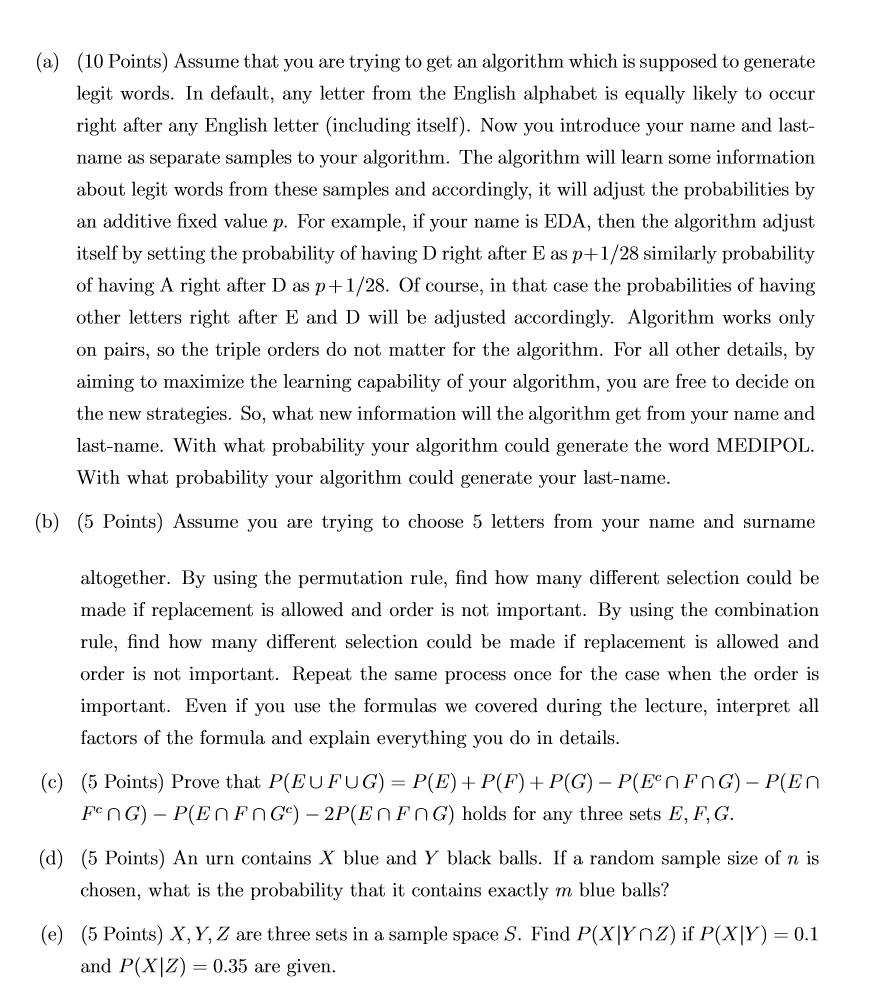Answered step by step
Verified Expert Solution
Question
1 Approved Answer
(a) (10 Points) Assume that you are trying to get an algorithm which is supposed to generate legit words. In default, any letter from

(a) (10 Points) Assume that you are trying to get an algorithm which is supposed to generate legit words. In default, any letter from the English alphabet is equally likely to occur right after any English letter (including itself). Now you introduce your name and last- name as separate samples to your algorithm. The algorithm will learn some information about legit words from these samples and accordingly, it will adjust the probabilities by an additive fixed value p. For example, if your name is EDA, then the algorithm adjust itself by setting the probability of having D right after E as p+1/28 similarly probability of having A right after D as p+1/28. Of course, in that case the probabilities of having other letters right after E and D will be adjusted accordingly. Algorithm works only on pairs, so the triple orders do not matter for the algorithm. For all other details, by aiming to maximize the learning capability of your algorithm, you are free to decide on the new strategies. So, what new information will the algorithm get from your name and last-name. With what probability your algorithm could generate the word MEDIPOL. With what probability your algorithm could generate your last-name. (b) (5 Points) Assume you are trying to choose 5 letters from your name and surname altogether. By using the permutation rule, find how many different selection could be made if replacement is allowed and order is not important. By using the combination rule, find how many different selection could be made if replacement is allowed and order is not important. Repeat the same process once for the case when the order is important. Even if you use the formulas we covered during the lecture, interpret all factors of the formula and explain everything you do in details. (c) (5 Points) Prove that P(EUFUG) = P(E) + P(F)+ P(G) P(ENFNG)- P(En FENG) - P(EnFnG)- 2P(ENFOG) holds for any three sets E, F,G. (d) (5 Points) An urn contains X blue and Y black balls. If a random sample size of n is chosen, what is the probability that it contains exactly m blue balls? (e) (5 Points) X, Y, Z are three sets in a sample space S. Find P(X|YnZ) if P(X|Y) = 0.1 and P(X|Z) = 0.35 are given.
Step by Step Solution
★★★★★
3.38 Rating (145 Votes )
There are 3 Steps involved in it
Step: 1
a The algorithm will learn that certain letters are more likely to occur after certain other letters ...
Get Instant Access to Expert-Tailored Solutions
See step-by-step solutions with expert insights and AI powered tools for academic success
Step: 2

Step: 3

Ace Your Homework with AI
Get the answers you need in no time with our AI-driven, step-by-step assistance
Get Started


